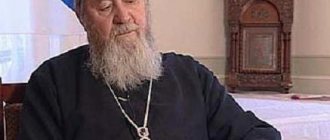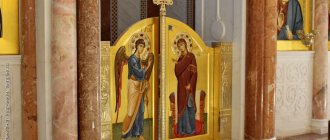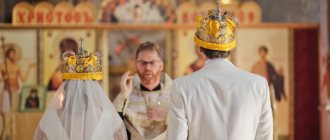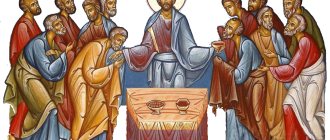“Go therefore and teach all nations, baptizing them in the name of the Father and the Son and the Holy Spirit. Teaching them to observe everything that I have commanded you” (Matthew 28:19-20).
In this global commission given from above to the first disciples and apostles of Christ
The call to educate sounds twice. That is why the need to reveal the meaning and content of the spiritual path to salvation has been facing the Church from the very beginning of its creation and is being realized at different levels of accessibility. One of the forms of church preaching is the catechism.
Icon of the Apostolic Sermons
Meaning of the word
The word “catechism” is of Greek origin and means a collection of doctrinal provisions that help to understand the fundamentals of religious doctrine. Simply put, this is a short primer on the essence of Christianity.
.
The first examples of such literature appeared in response to the request of the young, growing Church. The most famous monuments of early Christian thought are addressed to those wishing to be baptized
and
new ones
, the oldest among them is “Didache” (1st century).
These works contain the quintessence of Christian doctrine, but are not directly called catechisms. And in their free form they are very different from later religious literature of a didactic nature.
Interesting fact
The first books with the inscription “Catechism” on the cover were published only at the beginning of the 16th century.
Their authors were Catholics
and Protestants.
The classic form of a short guide to the basics of the Christian faith, “question and answer,” which has become established over time, arose in the West during the era of the Reformation. The most famous of them are Martin Luther's Small and Large Catechisms.
210. The Lord Jesus Christ showed the very first proof that His suffering and death are saving for people, by the fact that He was resurrected and thereby laid the foundation for our blessed resurrection. “Now Christ has risen from the dead, and is the Firstfruits of those who have fallen asleep” (1 Cor. 15:20).
211. The state in which Jesus Christ was after His death and before the Resurrection is spoken of in the following church hymn: “In the fleshly tomb, in hell with the soul like God, in heaven with the thief, and on the Throne were you, Christ , with the Father and the Spirit, fulfill all the Indescribable."
212. The word “hell” translated from Greek means a place devoid of light. In Christian teaching, this name refers to a spiritual prison, i.e. the state of souls cut off by sin from the sight of God and united with Him in light and bliss (Jude 1 :6. Octoechos, tone 5, stichera 2, 4).
213. The Lord Jesus Christ descended into hell in order to preach victory over death there too and to free the souls who were awaiting His Coming with faith.
214. There is the following evidence of this in the Holy Scriptures: “For Christ also (once) suffered for our sins alone, the Righteous for the unrighteous, that He might bring us to God: He was put to death in the flesh, but made alive in the Spirit, for Him and being a message came out in the spiritual prison" (1 Pet.3:18—19).
215. The words of the Creed “who was raised on the third day according to the Scriptures” are taken from the Epistle to the Corinthians: “I delivered it to you from the beginning, which I also received (I originally taught you what I myself accepted), because Christ died our sin for our sake, according to Scripture; and as he was buried, and as he rose again the third day, according to the Scripture" (1 Cor. 15:3—4).
216. The words “according to Scripture” mean that Jesus Christ died and rose again exactly as was prophetically written about in the books of the Old Testament.
217. For example, in the 53rd chapter of the book of the prophet Isaiah, the suffering and death of Jesus Christ is depicted in many detailed ways: “He was ulcerated for our sins and tormented for our iniquities; the chastisement of our peace is upon Him; by His wound we are healed” (Isa. 53 :5). About the Resurrection of Christ, the Apostle Peter quotes the words of Psalm 15 : “For Thou hast not left My soul in hell, nor let Thine saint see corruption” (Acts 2:27 ).
218. The Scriptures of the Old Testament also indicate that Jesus Christ had to rise precisely on the third day. A prophetic image of this is presented by the prophet Jonah: “And Jonah was in the belly of the whale three days and three nights” (Jon. 2:1).
219. People learned that Jesus Christ was resurrected in the following way.
The soldiers who guarded His tomb learned about this with horror, because the Angel of the Lord rolled away the stone with which His tomb was closed, and at the same time a great earthquake occurred. The angels also announced the Resurrection of Christ to Mary Magdalene and some others. Jesus Christ Himself, on the very day of His Resurrection, appeared to many: the myrrh-bearers, the Apostle Peter, two disciples going to Emmaus, and, finally, all the apostles who were in the house whose doors were closed. Then He appeared to them many times over a period of forty days; One day He appeared to more than five hundred faithful at the same time (1 Cor. 15:6).
220. Jesus Christ, after His Resurrection, appeared to the apostles for forty days because during this time He continued to teach them the mysteries of the Kingdom of God (Acts.1:3).
About the sixth article of the Creed
221. The reference to the Ascension of the Lord in the sixth member of the Symbol is borrowed from the following sayings of the Holy Scripture: “He who came down and ascended above all heavens, that he might fulfill all things” (in order to fill everything) (Eph. 4:10 ); “such are the imams (we have) the High Priest, who sits at the right hand of the Throne of the Majesty in Heaven” (Heb. 8 :1).
222. Jesus Christ ascended to Heaven as humanity, and as Divinity He has always been and remains in Heaven.
223. It is said that Jesus Christ sits at the right hand of God the Father, but God is Omnipresent. This must be understood spiritually, i.e. Jesus Christ has equal power and glory with God the Father.
About the seventh article of the Creed
224. The Holy Scripture says this about the future Coming of Christ: “This Jesus, who was taken up from you into Heaven, will come in the same way (in the same way) as you saw Him going into Heaven” (Acts 1:11 ). Angels told the apostles this during the Ascension of the Lord.
225. About the future Judgment, His Holy Scripture says this: “the hour is coming, in the same time (the time will come in which) all who are in the tombs will hear the voice of the Son of God, and they will come out having done good for the resurrection of life (life), and having done evil for the resurrection of judgment "(John 5 :28-29). These are the words of Christ the Savior Himself.
226. The Holy Scripture says this about His endless (Eternal) Kingdom: “He will be great and will be called the Son of the Most High, and the Lord God will give Him the throne of His father David, and He will reign in the house of Jacob forever, and His kingdom will have no end” ( Luke 1 :32-33). These are the words of the Angel addressed to the Mother of God.
227. The future Coming of Christ will be very different from the previous one. He came to suffer for us in humiliation, but He “will come to judge us... in His glory, and all the holy angels with Him” (Matt. 25:31).
228. He will judge all people without exception.
229. He will judge in such a way that the conscience of each person will open before everyone and not only all the deeds that someone has done throughout his entire life on earth will be revealed, but also all the words spoken, secret desires and thoughts. “The Lord will come, who will bring into light the secrets of darkness (illuminate what is hidden in darkness), and will reveal the counsels (intentions) of the heart, and then praise will come to everyone from God” (1 Cor. 4:5).
230. He, without a doubt, will condemn us for bad words or thoughts, if we do not blot them out with repentance, faith and correction of life, “I say to you: for every idle word that men speak (people will say), they will give a word about it (answer) on the Day of Judgment" (Matt.12:36).
231. When the Lord Jesus Christ will come to judge is unknown, but we must live in such a way that we are always ready for this.
“The Lord does not delay (in fulfilling) the promise, as some people think he has delayed (as some consider it delay), but is patient with us, not that some should perish, but that all may come to repentance. The day of the Lord will come like a thief in the night" (2 Pet. 3:9—10).
“Be on guard, for you do not know the hour of the day in which the Son of Man will come” (Matt.25:13).
232. In the word of God, some signs of the imminent Coming of Christ are revealed, namely: a decrease in faith and love between people, an increase in vices and disasters, the preaching of the Gospel to all nations, the coming of the Antichrist (Matt.24).
233. Antichrist is an opponent of Christ who will try to destroy Christianity, but will himself die in a terrible way (2 Thess. 2:8).
234. The Kingdom of Christ is, firstly, the whole world; secondly, all believers on earth; thirdly, all the blessed (i.e. righteous, saints) are in Heaven.
The first is called the kingdom of nature, the second the kingdom of grace, and the third the kingdom of Glory.
The first Orthodox catechisms published in Rus'
In the tradition of primary religious education in Rus', the following were used:
- simple primers;
- collections of prayers
with their interpretation; - missals
.
All these manuscripts necessarily contained the Creed.
.
Detailed lists of Christian virtues
could be found in various kinds of teachings, conversations contained in special books called “catechumens”. In turn, “catechumens” in Rus' were those who were preparing to be baptized.
The most popular reading in Russia were the lives
of saints,
whose exploits portrayed high examples of Christian life to grateful readers or listeners.
Trying to imitate these numerous worthy examples, man actually learned to comprehend the moral Law of God
.
Useful materials
At the disposal of the educated Russian clergy
and monasticism, there were also a large number of manuscripts with texts by respected Greek authors.
Thanks to a careful study of the works of the holy fathers
, such luminaries of spirituality appeared on our land as St. Sergius of Radonezh, who in his youth had the opportunity to explore the precious treasures of church thought.
The need for the appearance of catechisms itself was due to the opposition of our Church to numerous attempts to penetrate into the territory of Russia together with missionaries
and simply travelers of Catholic and Protestant views. Orthodox theology urgently needed active and serious defense, the creation of clear definitions of faith in the form of short textbooks.
The content of the first Russian catechisms was directed against the heterodox errors pouring in from the West.
- The work of Lavrenty Zizaniy Tustanovsky, which appeared in Western Rus' in 1620, set as its goal a victorious polemic with Catholicism, but itself fell under the influence of the latter. The book of Zizania contained an entire treatise dedicated to purgatory.
- In 1720, a primer called “The First Teaching of a Youth” was published, compiled by Archbishop of Novgorod Feofan Prokopovich, which, along with questions and answers, contained the commandments of the Old Testament Decalogue
. Armed with the methods of Protestant science in the fight against Catholic scholasticism, this primer went to a new extreme.
Interesting fact
A very interesting fact should be noted.
Emperor Peter I himself declared the need to create a catechism understandable to the common people. In his opinion, expressed in a message to the Synod
, this simple book should contain “instructions that there is a direct path to salvation... and especially faith, hope and love ( for they know very little about the first and last... and they haven’t even heard of the middle one), since they put all their hope in church singing, fasting and bowing, and so on...”
Confession of Metropolitan Peter Mohyla
“The Orthodox Confession of Faith of the Catholic and Apostolic Church of the East” is the result of the collective creativity of Metropolitan Peter himself and his associates.
The first edition took place in 1642 in Latin, a version in Greek appeared a year later, and a translation into Church Slavonic was published in 1685.
Even fairly cleaned up of the influence of scholasticism for translation into colloquial Greek, Peter Mogila’s document remains the most “Latin-wise” Orthodox text of the 17th century. Having been translated into Russian in 1837, this work has been used since the end of the 19th century. the adequacy of the transmission of Orthodox doctrine has been disputed.
The purpose of the catechism is indicated in the preface to it:
“This book is published not only so that priests in their parishes read and explain it to their parishioners every day, especially on Sundays and holidays; but also that worldly people who know how to read teach the Christian doctrine in the same way, especially that parents teach their children from it, and the owners of the people under their control, and also that in schools all teachers force their students to learn by heart from this book.”
The “Orthodox Confession” has a symbolic three-part form:
- the first part examines the Creed;
- the second part is devoted to prayer and the beatitudes;
- the third part completes the study of the fundamentals with an appeal to good deeds.
Work of Metropolitan Platon (Levshin)
A good attempt to correct the situation with spiritual illiteracy was the work of the future metropolitan
Plato (Levshin). It was called "The Catechism, or the original instruction in the Christian law, publicly interpreted in 1757-1758."
Metropolitan Platon (Levshin)
This collection of accessible conversations described the process of preparing a believer to enter the Church over a period of 9 months, like the gradual growth of a baby in the womb. The catechism was wittily tied to the annual liturgical circle and was completely devoid of any harmful scholasticism.
Subsequently, Levshin created several more collections, both to help the clergy and for the personal use of the heir to the throne, young Paul. It is in the works of this church figure that we find the first serious appeal to the patristic tradition. His catechisms were in demand by Russian Orthodox society until the end of the 19th century.
Long Catechism of Metropolitan Philaret (Drozdov)
The official order of the church authorities for the appearance of a unified textbook on the fundamentals of faith, which should fully satisfy the needs of education, arose as a result of the reform at the beginning of the 19th century. Its implementation was entrusted to Philaret, a student of Metropolitan Platon.
Saint Philaret of Moscow
“Long Christian Catechism of the Orthodox Catholic Eastern Church” by Philaret (Drozdov) was published in 1823. The ardent desire to continue the work of his teacher in a patristic manner found opposition in the context of pro-Catholic trends.
Metropolitan Philaret of Moscow had to adjust his work.
The revised version included the Catholic doctrine of predestination, replaced quotes in Russian with Church Slavonic, and added a chapter on Holy Tradition
. Despite the objections of Metropolitan Philaret himself to many edits, it was published in 1839.
The reaction of educated society to this work was far from unambiguous. Some reproached him for statements that were dangerous for Orthodoxy, others emphasized the complexity of the text and provisions of the spiritual textbook for ordinary lay people.
Nevertheless, Drozdov’s creations were taken for a long time as the basis of spiritual religious education in Russia.
Interesting fact
To this day, the work of Metropolitan Philaret, as amended by members of the Synod, remains the only generally accepted catechism in the Russian Orthodox Church.
Read online “Worm”
Tim Curran
WORM
1
Like most days, this one started out badly.
Before she left for work, Charice told Tony to remember to take Stevie for a walk. You see, walks in the park are good for the heart and circulatory system, and therefore good for health and longevity. Not Tony, of course - hell, he's just her husband - but the dog. Stevie. In Tony’s opinion, it would be difficult to come up with a more “faggot” name for a dog, but Stevie was a natural “faggot” dog - half-Spitz, half-poodle. The dog-loving Charis called him a “tame dog,” and Tony himself simply called him “a misunderstanding.”
A tame dog? No, legged dog! This is when he starts yapping in his “fag” voice and you give him a kick.
Charis thought it wasn't funny at all. And she didn’t like it when he asked her to get rid of this vile freak and get a normal dog - a Labrador, a collie or a shepherd.
No, she picked up her little mongrel in her arms and kissed him on the unsightly flattened muzzle. “Mommy loves her puppy, her baby, her Stevie-weevee. "Smack-smack-smack. God. Yes, this can make you sick!
When Tony finally dragged his ass out of bed, stretched and yawned, the little beggar was already waiting for him. God, you should have seen his eyes! It was as if Stevie understood everything. That Momma Charice is the one pulling the weights, and Tony is an unemployed slob, a second-class citizen, an obedient servant who mops the floors, answers the phones, scrubs the toilet, cooks the casserole, walks baby Stevie-weevee, and cleans up his crap from the living room carpet. That Mommy Charice holds Tony tightly by the balls and when she tells him to jump, he not only asks how high, but also whether he should do a fucking somersault or a double pirouette while jumping.
God, that damn dog understood everything.
“Okay, mongrel,” Tony said. “Let me just lay down a couple of bricks and pour them, and then we’ll go.”
Stevie barked... No, he barked squeaky. If Gollum were a dog, this is how he would bark.
Stevie glared at Tony. Okay, lazy slob, but hurry up, because I'm not your boy, and my bladder isn't what it used to be, okay?
- Fuck you! - Tony said, swinging his leg at the dog.
Stevie dodged and bared his teeth.
. Then he rolled his eyes again. Do you want to take a look, you useless slug? I'll tell Mommy everything, and she'll throw your dead ass out into the street. You don't want her to choose between us, do you? You don't want this, do you?
Then the phone rang. Sighing, Tony picked up the phone. - Yes? - he said.
- Hi Tony. “The call was from their neighbor, Stephanie, a curvaceous blonde whose green eyes made him weak at the knees. - This is Steph. Charis told me to call you. Reminded me about the dog.
- How thoughtful of her.
- Oooh, you're out of sorts. But I didn’t do anything wrong.
- Sorry.
- So what’s on your busy schedule today besides walking Stevie? “There was sarcasm in her voice.
- Today I am free all day. And in the evening I have a date with a pool cue.
“Ohhh,” she said. “I wouldn’t refuse such a date either.”
- It started again.
- Ha. In short, I just got out of the shower, and I can’t stand here naked, otherwise water is dripping off me.
Shameless little flirtation.
“I can bring a towel,” he said, already drawing pornographic pictures in his head...
Modern editions
Currently, the Russian Orthodox Church is working to create a new document that meets the needs of society in content and style.
Attempts are being made to present the fundamentals of the doctrine in a new way. The work of Rev. is widely known. Oleg Davydenkov “Catechism. Introduction to Dogmatic Theology". It is used today as a recommended manual in theological schools.
The draft of the official catechism of the Russian Orthodox Church was prepared by the Synodal Biblical and Theological Commission, headed by Metropolitan Hilarion (Alfeev). It was published in 2021 for church-wide discussion.
Today this work continues taking into account the adopted amendments and proposals.
Benefits for children
Individual Orthodox catechisms for children's audiences are appearing in our time. In 1995, “Catechism in Stories” by S. Uspensky was published. And in 2014, Deacon Georgy Maximov’s book “Catechism for Children” was published, consisting of 37 separate parts.
"Faith of the Saints" St. Nikolai Serbsky
It is not for nothing that Saint Nicholas (Velimirović) is called the “Serbian Chrysostom”. His works are included in the treasury of Orthodox thought of the 20th century.
Work of St. Nicholas, which can be classified in form and content as literature for teaching the basics of the Christian faith, is called “The Faith of the Saints.” This is a classic dialogue in the form of questions and answers, with the help of which the teaching of the Orthodox Church is presented.
Proclamation of the Decembrist S.I. Muravyov-Apostol
The concept of “catechism” was used not only to designate doctrinal literature. Any profound manual that was schematically similar to a religious document was called a catechism. An example of this is the “Orthodox Catechism” by Muravyov-Apostol.
This proclamation of revolutionary content was read out on the morning of December 31, 1825 in St. Petersburg in front of the line of rebel soldiers of the Chernigov regiment. The document advocated the creation of a democratic republic and was anti-serfdom in its content, calling for the overthrow of the tsar and an immediate uprising against those in power.
The calls for riots against the existing government here directly referred to biblical texts. In addition, the “Orthodox Catechism” of the Decembrists provides a Christian justification for the need for military service; patriotic motives of love for the Fatherland are based on eternal truths.






